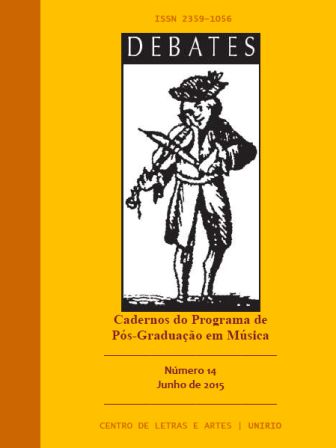A instalação sonora como espaço de arte plural: a questão da interpretação de obras onde a electrónica e a interação humanas se encontram ao serviço da sua determinação
Resumo
Resumo: a interação entre o humano e o instrumental, o instrumental e o electrónico, o pré-gravado (fixo) e o interativo (modulável), despoleta uma nova forma de criação artística onde a interação reciproca se trona fundamental. Quando a esses espaços se sobrepõem outros de texto e imagem, e quando estes se manipulam e regem mutuamente, os criadores desenvolvem espaços de arte que se tornam abertos e plurais. Neste fazer, uma interpretação de obra não se rege mais pelos cânones mais convencionais, adquirindo uma outra forma de se ser, e, estar. Por outro lado, e porque tem sido frutífera a relação criativa que ocorre entre o compositor português António de Sousa Dias e muitos outros artistas, na produção de obras de arte plurais, espaços de arte interativos onde a componente sonora e visual sobressai, decidimos dedicar a nossa atenção a toda a sua produção artística, nomeadamente para duas obras deste compositor onde a interação entre criador, intérprete e fruidor, se revela fundamental na determinação da sua interpretação. Simultaneamente, a questão do estudo e desenvolvimento, através da arte, dos espaços arquitectónicos da sala de concerto, nomeadamente em função da sua capacidade de modulação dos estratos de significação de uma obra, são relevados em muitas das suas propostas artísticas. Neste trabalho, analisaremos as obras Tonnetz 09-B (2010) e A Dama e o Unicórnio (2013) para demonstrar como se formam enquanto espaços de arte, bem como os problemas de interpretação e criação que encerram. Através deles, queremos perceber como são manifestos os seus conteúdos sonoros, musicais, imagéticos e visuais, bem como se relacionam, e no caso de A Dama e o Unicórnio, com os conteúdos poéticos de Maria da Teresa Horta e o espaço físico da sala de concerto - O Jardim de Inverno do Teatro de São Luíz em Lisboa. Pretendemos ainda verificar como se constituem, e através da interpretação, em novos espaços de arte.
Palavras-chave: António de Sousa Dias. Música Eletrónica. Música Eletroacústica. Interpretação Musical. Instalação multimédia interativa. A Dama e o Unicórnio. Tonnetz 09-B.
Sonorous and multimedia installation as a plural art space: the question of interpretation of artistic works where the electronic and human interaction are at the service of its determination
Abstract: The interaction between the human and the instrumental, the instrumental and the electronic, the pre-recorded (fixed) and the interactive (modular), triggers a new form of artistic creation where the reciprocal interactions are fundamental. When these spaces overlap other text and image, and when they manipulate and govern each other, the creators develop art spaces that become open and plural. In this way of making an interpretation of one work, this is not ruled by more conventional canons, acquiring another way of being, and existence. On the other hand, and because it has been fruitful creative, the relationship that occurs between the Portuguese composer António de Sousa Dias and many other artists in the production of plural works of art, the interactive art spaces that occurs when the sound and visual component stands out, we decided to dedicate our attention to all of these artistic production, in particular for two works of this composer where the interaction between creator, performer and spectator, is crucial in determining their interpretation. At the same time, the question of the study and development through art, architectural spaces of the concert hall, especially in terms of their ability to modulate the meaning of a work of strata, are included in many of its artistic proposals. In this paper, we analyze the works Tonnetz 09-B (2010) and The Lady and the Unicorn (2013) to demonstrate how their form creates art spaces and also how the problems of interpretation and creation enclosing in the art product that results. Through them, we realize how obvious is their sound, music, imagery and visual content and relate, and in the case of The Lady and the Unicorn, with the poetic content of Maria Teresa Horta and the physical space of the room Concert - The Winter Garden of the Sao Luiz Theatre in Lisbon. We also want to see how they are, and through interpretation, they come new art spaces.
Key-words: António de Sousa Dias. Electronic Music. Electroacoustic Music. Musical Interpretation. Multimedia Interactive Installation. A Dama e o Unicórnio, Tonnetz 09-B


